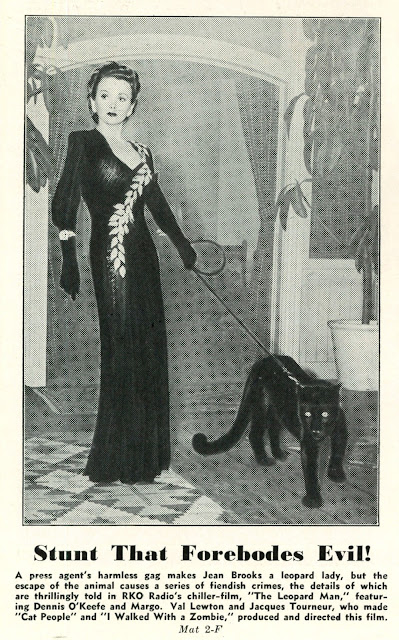Lewton Back In Fang and Claws
The Leopard Man (1943) Brings Out The Beast In Showmen
 |
| Two Lewton Thrillers Combine For Chicago First-Run |
The Lewton series for RKO was stair-steps that went down, each new one earning less than the last. Trouble too was cost creeping up as the series went along. B pictures could not sustain like this, being a category where you needed to know close to a penny what your merchandise would bring back. Cat People would be the only true sleeper of the Lewton lot, that is in terms of being an unexpected critical and commercial success. Next to The Body Snatcher, it would be the largest grosser of the group. There was profit, if less of it, for The Leopard Man, thanks most likely to exploitable elements. There was no supernatural card in the deck, as here was horror more psycho-sexual than where monsters loomed large, so yes, you could say this was a “First Time On Any Screen.” Ads argued that a leopard man, serially killing helpless women, was a force driven not by bloodlust, but plain lust. I’m a little surprised The Leopard Man didn’t gross better than it did. Maybe word-of-mouth hobbled it. The Motion Picture Herald’s reviewer (5-8-43) saw clouds gather at a preview screening, “There were perhaps a half-dozen or more walkouts during the unreeling. Noticeably lacking to this reviewer was the tenseness among the audience that generally pervades the screening of a horror thriller.” Scare pics almost never met heights of breathless advertising, customers accustomed enough to that, but there were creep goals that had to be met for value in your quarter, those walkouts certain to tell friends that The Leopard Man dropped its ball.
Censorship was what took juice out of gothic fruit. The Code was just pitiless where horror films were submitted, and why would studios spend chips arguing on monster behalf considering low priority the stuff had to begin with? The Leopard Man was a mystery draped in horror’s cloak. Val Lewton and director Jacques Tournear devised stalk scenes to justify a chiller label, whole of The Leopard Man hanging on one/two segments to haunt dreaming even of those otherwise let down. Whatever the limits of what he showed, Lewton could always fall back on all colors of his dark, which a PCA couldn’t very well ink out. Most Lewton payoffs occur where we don’t see, or barely can, as in long walk for an adolescent girl who gets home only for the door to be locked against her, helpless pounding no good to gain entry and prolonged enough so the leopard behind will catch up. It’s a classic sequence for which The Leopard Man is best remembered today. What happens after is more conventional business (though not necessarily so in 1943) of human agency behind “leopard” murders and ultimate unmasking of the killer.
The Leopard Man would enjoy the most extensive revival of any Val Lewton film thanks to service as a second feature for 1952 engagements of King Kong. The combo was a summer phenomenon driven by TV saturation. King Kong was, of course, what customers came to see, but The Leopard Man went with it in virtually all situations, and like Kong would earn more than in its original release. Many a moppet sat through The Leopard Man for no reason other than to gorge on Kong a second time. Example of the pair filling seats was a June 1952 week, plus four holdover days, at the RKO Palace in Cleveland, Ohio (ad at right), where Kong/Leopard "did a better business than any first-run film the Grand has played in the last few months." Lines down a city block brought complaint from merchants that youngsters (60% of attendance, said Variety) were blocking entrance to neighboring shops. Ads like the RKO Palace's told the story ... The Leopard Man was mostly there to clear seats for a next run of the show crowds came for, but Lewton's thriller got massive trickle-down, as did others of his backlog that returned during the 50's. A meaningful boost lay in fact that RKO made safety prints of The Leopard Man for a first time on this occasion, hundreds of them to service saturation dates for the double bill. Many of these prints would stay in circulation for years to come. Afterlife of The Leopard Man was further enhanced by release to television in 1956, its reputation burnished the more when historians took it up with other Lewtons from the early 70's forward (Joel Siegel's 1973 book, Val Lewton: The Reality Of Terror a major step toward that direction).












3 Comments:
The Leopard Man is a favorite. I can--and have--watched it any time it pops up. While possibly not the best strategy for "just a chiller," I love how much personality (and screentime) it gives bit/background characters like the fortune teller, Clo-Clo, Charlie How-Come, etc. Makes it rewatchable long after you know who the killer is.
Jean Brooks makes quite the entrance in that black(?) evening gown with the leaf pattern (featured in one of your promo stills), it's certainly the best she ever looked on film.
Seeing your welcome piece on "The Leopard Man" made me think back to some words I wrote about Jean Brooks in a blog post almost ten years ago.
"Most definitive and haunted of Val Lewton’s heroines, which is saying something. Brooks’ eyes, her voice, her essence - all marked her as some sort of hushed embodiment of existential sadness. A troubled personal life – echoes of which undoubtedly resonated in her onscreen persona - seems to have been one of the factors that kept Jean Brooks from the stellar career she deserved. A loss for all of us.
Key year:1943–with two Lewton masterpieces - THE SEVENTH VICTIM and THE LEOPARD MAN."
I think I'll rewatch one of them tonight.
Post a Comment
<< Home